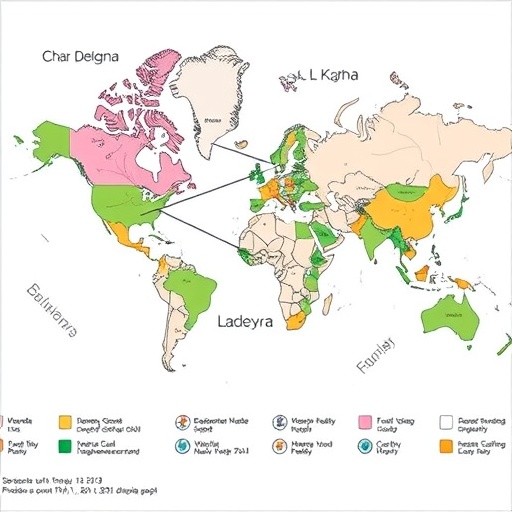
In the intricate tapestry of global biodiversity, the phenomenon of species invasion has garnered considerable attention from ecologists and conservationists alike. As ecosystems become increasingly influenced by human activities, the introduction of non-native species has sparked debates regarding their ecological impact and the processes underlying such invasions. The recent research conducted by Uwalaka, Borisade, and Westwood sheds light on this pressing issue, proposing that biological traits serve as significant indicators for predicting the invasiveness of various species.
Invasive species are often characterized by their ability to thrive in new environments, outcompete native species, and ultimately disrupt local ecosystems. Opportunities for these invasions are frequently created through human activities, such as international trade and transportation, which facilitate the movement of species across geographic borders. As various ecosystems face mounting pressures from climate change and anthropogenic disturbances, understanding the traits that predispose certain species to become invasive is paramount for developing effective management strategies.
The study emphasizes that biological traits — including reproductive strategies, growth rates, and physiological tolerances — play a crucial role in assessing the potential invasiveness of a species. For instance, species with high reproductive rates and flexible growth patterns may be more likely to establish themselves in new environments and outcompete established flora. Such traits serve as adaptive mechanisms that enable invasive species to thrive in diverse conditions, often at the expense of native species that lack similar capacities.
Furthermore, the comparative analysis conducted by the researchers juxtaposes invasive and native species, revealing stark differences in their biological traits. Invasive species were found to exhibit a broader range of phenotypic plasticity, allowing them to adjust swiftly to fluctuating environmental conditions. This adaptability contrasts sharply with many native species, whose traits may be more specialized and less versatile, thus rendering them vulnerable in the face of competition from more adaptable invaders.
One key finding of the research highlights that the traits promoting invasiveness are not limited to just one aspect of biology but are multi-faceted. For example, the ability to utilize diverse resources, high dispersal capabilities, and resistance to predators are all traits that can enhance the success of an invasive species. These characteristics enable them to establish themselves quickly and occupy niches that might otherwise remain unfilled by native species, further complicating the dynamics of ecosystem health.
Moreover, the researchers emphasize the need for early identification and monitoring of potential invasive species based on their biological traits. By utilizing trait-based assessments, conservationists and environmental managers can prioritize species for management before they have the chance to establish and spread. This proactive approach may minimize the extensive ecological and economic damages that often accompany invasions.
The implications of these findings are not merely academic; they resonate with policymakers and environmental management agencies worldwide. By incorporating trait-based assessments into their frameworks, these entities can develop more effective control measures and allocate resources more efficiently. Importantly, such strategies could aid in preserving biodiversity, enhancing ecosystem stability, and safeguarding the natural environments that billions of people rely upon for their livelihoods.
Understanding the relationships among traits, environment, and species success could usher in new methodologies for ecological modeling and risk assessment. The study’s innovative approach not only reinforces existing ecological theories but also paves the way for fresh research avenues exploring the intersection of traits and invasiveness.
As we confront the realities of global climate change and habitat loss, the research from Uwalaka and colleagues underscores an increasingly urgent message: that the biological traits of species are critical to forecasting invasiveness. This knowledge equips scientists with the tools necessary to develop predictive models that account for the complex dynamics of ecosystems, thereby improving our capacity to manage them sustainably.
Invasive species are not merely ecological nuisances; their impacts ripple through ecological communities, affecting food webs, nutrient cycling, and habitat integrity. As researchers continue to unravel the intricacies of invasiveness, the integration of biological traits into ecological research represents a fundamental shift in how we perceive and manage biodiversity. Each finding contributes a piece to the larger puzzle of ecological understanding, guiding us towards a balanced coexistence with the natural world.
Ultimately, this study serves as a call to action for the conservation community. It reiterates the importance of research that bridges the gap between biology and ecological management. As science continues to grapple with the complexities of species invasiveness, embracing trait-based methodologies can empower conservation efforts and enhance our ability to protect fragile ecosystems worldwide.
The insights from Uwalaka, Borisade, and Westwood offer hope for future research directions and management practices aimed at safeguarding biodiversity. With continuous advancements in our understanding of invasive species and their traits, we can aspire to foster healthier environments, ultimately benefiting all forms of life that inhabit our planet.
By leveraging these biological insights, conserving biodiversity can transition from reactive to proactive measures. This transformative change in perspective may very well define the next era of ecological stewardship, ensuring that our natural habitats are preserved for generations to come.
Subject of Research: Predicting invasiveness of species based on biological traits.
Article Title: Biological traits are important characters for predicting invasiveness of species: a comparative study between invasive and native species.
Article References:
Uwalaka, N.O., Borisade, T.V. & Westwood, R. Biological traits are important characters for predicting invasiveness of species: a comparative study between invasive and native species.
Discov. Plants 2, 229 (2025). https://doi.org/10.1007/s44372-025-00314-0
Image Credits: AI Generated
DOI: 10.1007/s44372-025-00314-0
Keywords: Invasive species, biological traits, biodiversity, ecological management, phenotypic plasticity.
Tags: anthropogenic disturbances and ecosystemsbiological traits and species invasivenessclimate change and species invasionecological disruption by invasive speciesecological impact of non-native speciesglobal biodiversity and invasivenessgrowth rates and species establishmenthuman activities and biodiversitymanagement strategies for invasive speciesphysiological tolerances in ecologypredicting invasive species behaviorreproductive strategies in invasive species




